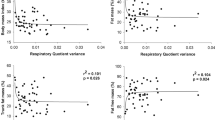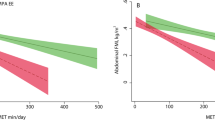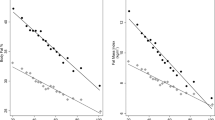Abstract
Objectives: To estimate the energy cost of resting (RMR), sitting and standing for urban Indian adults and compare these estimates with the reported values.
Design: Energy costs were measured using oxylog while body fat was estimated using equipment (HBF300, OMRON Corporation, Japan) that works on the principle of bioelectrical impedance, for 24 men and 40 women, aged 20–50 y, engaged in sedentary activities.
Settings: Agharkar Research Institute, Pune, India.
Results: Mean energy cost (kJ/min) of resting (RMR), sitting and standing were significantly (P<0.01, for all) higher for men (4.01±0.42, 5.0±0.72 and 5.74±0.69, respectively) than women (3.54±0.28, 4.03±0.41 and 4.35±0.52, respectively). Gender difference increased with the level of activity, from 13% for RMR to 32% for standing. These differences reduced when adjusted (using analysis of covariance) for body weight and became non-significant on adjusting for fat-free mass (FFM) in the case of RMR and sitting activity. The measured values of energy cost (absolute and per kg weight) for these activities were similar to African subjects but lower compared to Asian or European subjects for both sexes. The stepwise regression analysis done separately by sexes showed weight (29%) in men and body mass index (44%) in women to be the best predictors of RMR, while regression analysis for combined sexes indicated FFM and height as predictors of RMR (r2=56%, P<0.01). If means to estimate body fat were not available, RMR could best be predicted with BMI and sex as predictors (r2=55%; P<0.01). This was mainly due to the fact that the sex differences in our population were more prominent in FFM than that in BMI. Our observations thus indicate the need to develop prediction equations separately for different populations owing to differences in their body compositions, especially in fat mass (FM) or FFM.
Conclusion: The energy costs of activities were associated with body composition, especially with absolute fat-free mass, which may vary even with the same body fat percentage. Therefore, there is a need to develop separate prediction equations for different communities.
Sponsorship: Agharkar Research Institute, Pune, India.
European Journal of Clinical Nutrition (2001) 55, 708–713
This is a preview of subscription content, access via your institution
Access options
Subscribe to this journal
Receive 12 print issues and online access
$259.00 per year
only $21.58 per issue
Buy this article
- Purchase on Springer Link
- Instant access to full article PDF
Prices may be subject to local taxes which are calculated during checkout
Similar content being viewed by others
References
Arciero PJ, Goran MI & Poehlman ET (1993) Resting metabolic rate is lower in women than men J. Appl. Physiol. 75 2514–2520
Banarjee S, Barua A & Ghosh A (1961) Energy metabolism in college girls J. Appl. Physiol. 16 164–169
Barnes DL, Adair LS & Popkin GM (1991) Women's physical activity and pregnancy outcome—a longitudinal analysis from Philippines Int. J. Epidemiol. 20 162–172
Bernstein M, Sloutskis D, Kumanyika S, Sparti A, Schutz Y & Morabia A (1998) Data based approach for developing a physical activity frequency questionnaire Am. J. Epidemiol. 147 147–154
Bhattacharya AK & Banarjee S (1963) Energy intake and energy expenditure of male medical college students of Rajasthan Ind. J. Med. Res. 51 350–356
Bleiberg FM, Brun TA, Goihman S & Gouba E (1980) Duration of activities and energy expenditure of female farmers in dry and rainy seasons in Upper Volta Br. J. Nutr. 43 71–82
Chiplonkar SA, Agte VV, Gokhale MK, Kulkarni W & Mane ST (1992) Energy intake and resting metabolic rate of young Indian men and women Ind. J. Med. Res. (B) 96 250–254
Cunningham JJ (1991) Body composition as a determinant of energy expenditure: A sysnthesis review and a proposed general prediction equation Am. J. Clin. Nutr. 54 963–969
Dauncy MJ & Bingham SA (1983) Dependence of 24 hr energy expenditure in man on the composition of nutrient intake Br. J. Nutr. 50 1–13
Durnin JVGA & Passmore R (1967) Energy Work and Leisure London: Heinemann
Durnin JVGA & Womersley J (1974) Body fat assessment from total body density and its estimation from skinfold thickness: measurements on 481 men and women aged from 17–72 y Br. J. Nutr. 32 77–97
FAO/WHO/UNU (1985) Energy and protein requirements Report of a joint FAO/WHO/UNU Expert Consultation. Technical Report Series no. 724 Geneva: WHO
Geissler CA, Brun TA, Mirbagheri I, Sohel A, Nabhigi A & Hedayat H (1981) The energy expenditure of female carpet weavers and rural women in Iran Am. J. Clin. Nutr. 34 2776–2783
Geissler CA, Mazine S & Hamod Aldouri (1985) Racial differences in the energy cost of standardised activities Ann. Nutr. Metab. 29 40–47
Hayter JE & Henry CJK (1994) A re-examination of basal metabolic rate predictive equations: the importance of geographic origins of subjects in sample Eur. J. Clin. Nutr. 48 702–707
Henry CJK & Rees DG (1988) A preliminary analysis of basal metabolic rate and race In Comparative Nutrition Proceedings of the Rank Prize fund's International Symposium on Nutrition, eds. K Blaster & I Macdonald 149–159 London: John Libbey
Henry CJK & Rees DG (1991) New predictive equations for the estimation of basal metabolic rate in tropical peoples Eur. J. Clin. Nutr. 45 177–185
Lawrence M, Singh J, Lawrence F & Whitehead RG (1985) The energy cost of common daily activities in African women: increased expenditure in pregnancy Am. J. Clin. Nutr. 42 753–763
McNeil G, Rivers JPR, Payne PR, De Britto JJ & Abel R (1987) Basal metabolic rate of Indian men: no evidence of metabolic adaptation to a low plane of nutrition Eur. J. Clin. Nutr. 41C 473–483
Mifflin MD, Sachiko T, Jeor ST, Hill LA & Scott BJ (1990) A new predictive equation for REE in healthy individuals Am. J. Clin. Nutr. 51 241–247
Norgan NG, Ferro-Luzzi A & Durnin JVGA (1974) The energy and nutrient intake and energy expenditure of 204 New Guinean adults Phil. Trans. R. Soc. Lond. 268 309–348
Owen OE, Kavle EC, Owen RS, Polansky M, Caprio S, Mozzoli MA, Kendrick ZV, Bushman MC & Boden GH (1986) A reappraisal of the caloric requirements of healthy women Am. J. Clin. Nutr. 44 1–9
Owen OE, Holup JL, D'Allessio DA, Craig ES, Polansky M, Smalley KJ, Kavle EC, Bushman MC, Owen LR, Mozzoli MA, Kendrick ZV & Boden GH (1987) A reappraisal of the caloric requirements of men Am. J. Clin. Nutr. 46 875–885
Piers LS & Shetty PS (1993) Basal metabolic rates of Indian women Eur. J. Clin. Nutr. 47 586–591
Piers LS, Diffey B, Soares MJ, Frandsen SL, McCormack LM, Lutschini MJ & O'Dea K (1997) The validity of predicting the basal metabolic rate of young Australian men and women Eur. J. Clin. Nutr. 51 333–337
Poehlman ET & Toth MJ (1995) Mathematical ratios lead to spurious conclusions regarding age- and sex-related differences in resting metabolic rate Am. J. Clin. Nutr. 61 482–485
Siri WE (1956) The gross composition of the body Adv. Biol. Med. Phys. 4 239–280
Soares MJ & Shetty PS (1988) Validity of Schofield's predictive equations for basal metabolic rates of Indians Ind. J. Med. Res. 88 253–260
Soares MJ, Sheela ML, Kurpad AV, Kulkarni RN & Shetty PS (1989) The influence of different methods on basal metabolic rate measurements in human subjects Am. J. Clin. Nutr. 50 731–736
Soares MJ, Francis DG & Shetty PS (1993) Predictive equations for basal metabolic rates of Indian males Eur. J. Clin. Nutr. 47 389–394
Soares MJ, Piers LS, O'Dea K & Shetty PS (1998) No evidence for an ethnic influence on basal metabolism: an examination of data from India and Australia Br. J. Nutr. 79 333–341
Valencia ME, Moya SY, McNeill G & Haggarty P (1993) Basal metabolic rate and body fatness of adultmen in northern Mexico Eur. J. Clin. Nutr. 48 205–211
Voorrips LE (1993) Energy expenditure at rest and during standardised activities: a comparison between elderly and middle aged women Am. J. Clin. Nutr. 58 15–20
WHO (1973) Energy and protein requirements Report of the Joint FAO/WHO Ad hoc Expert Committee. Technical report series no. 522 15–21 Geneva: WHO
Acknowledgements
We are grateful to Dr VS Rao, Director, ARI for encouraging and providing the facilities to carry out this work in the Institute. The authors also express appreciation to volunteers from Agharkar Research Institute for their co-operation during the experiment.
Author information
Authors and Affiliations
Corresponding author
Rights and permissions
About this article
Cite this article
Kanade, A., Gokhale, M. & Rao, S. Energy costs of standard activities among Indian adults. Eur J Clin Nutr 55, 708–713 (2001). https://doi.org/10.1038/sj.ejcn.1601211
Received:
Revised:
Accepted:
Published:
Issue Date:
DOI: https://doi.org/10.1038/sj.ejcn.1601211
Keywords
This article is cited by
-
Can Physical Activity While Sedentary Produce Health Benefits? A Single-Arm Randomized Trial
Sports Medicine - Open (2020)
-
Gross and relative energy cost of domestic household activities in Asian men
European Journal of Clinical Nutrition (2016)



